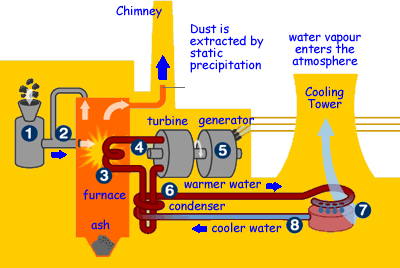|
Power Stations  Electricity is a very versatile form of energy. It is essential for our modern lifestyle. Power stations are big scale producers of electricity (hundreds of megawatts or gigabits of electricity). They are usually built in remote areas. The energy from them is transported to the towns via an electrical grid system. Common energy sources used to power electricity power stations are:
The heat produced in all of these power stations is used to boil water and then the steam produced drives a turbine which is coupled to an electrical generator. Electricity is then produced by electromagnetic induction. Click here for an interactive power plant that you can play with! Pollution problems Fossil fuel power stations contribute to global warming because they increase the proportion of CO2 in the atmosphere and coal in particular is 'dirty' adding sulphur dioxide to the atmosphere which creates acid rain problems. Cost The cost of building power stations is very high and it takes a long time to start-up and close down energy production safely. This varies between power station types but is true for all - they cannot be suddenly switched off! Other types of power generation Energy from renewable energy sources can be used to drive turbines directly - missing out the need to produce heat energy. Renewable energy sources used in this way include:
The output of these can generally be switched on and off more easily but they are generally smaller in scale than the fossil fuel/nuclear stations (except HEP which can be massive if there is a big body of water being used). Teachers click here to download a pdf worksheet based on this page
|
Follow me...
|






